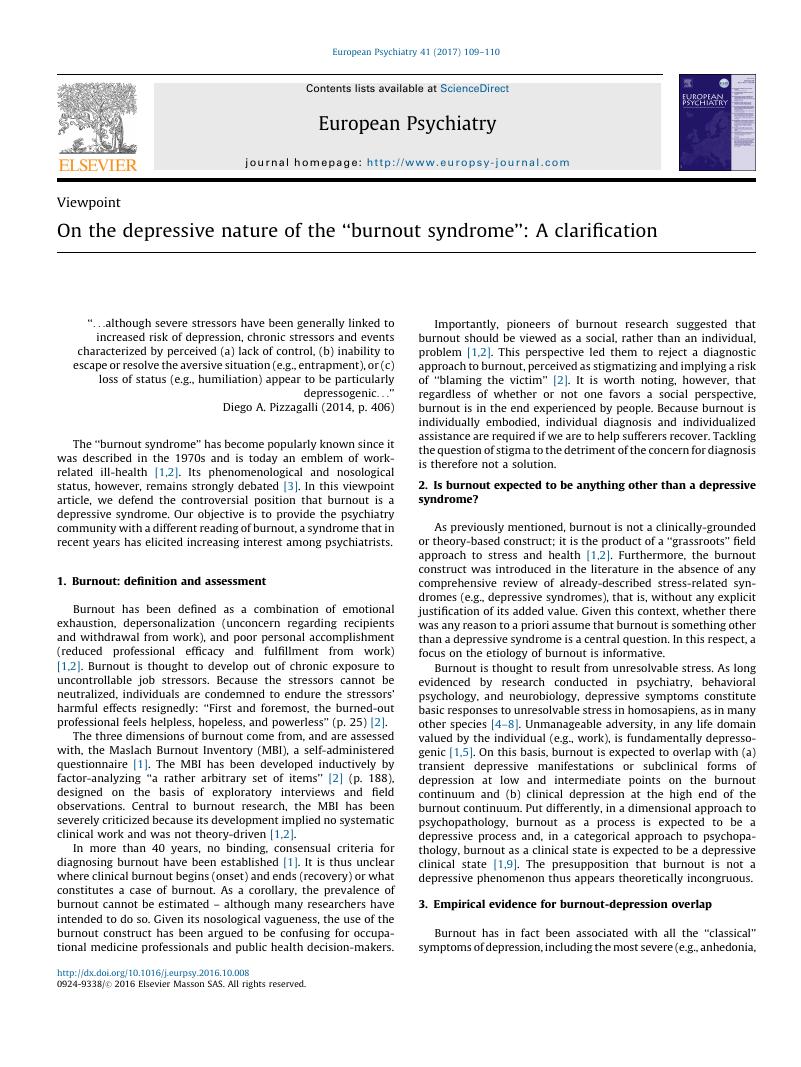Crossref Citations
This article has been cited by the following publications. This list is generated based on data provided by Crossref.
Bianchi, Renzo
Schonfeld, Irvin Sam
and
Laurent, Eric
2017.
Burnout syndrome' – from nosological indeterminacy to epidemiological nonsense.
BJPsych Bulletin,
Vol. 41,
Issue. 6,
p.
367.
Brisson, Romain
and
Bianchi, Renzo
2017.
Burnout: A Clinical and Sociological Reflection.
Journal of the American College of Radiology,
Vol. 14,
Issue. 7,
p.
861.
Bianchi, Renzo
Schonfeld, Irvin Sam
and
Laurent, Eric
2017.
Burnout symptoms: Depressive manifestations under psychosocial labels?.
Asia-Pacific Psychiatry,
Vol. 9,
Issue. 3,
Laurent, Éric
Bianchi, Renzo
Schonfeld, Irvin Sam
and
Vandel, Pierre
2017.
Editorial: Depression, Burnout, and Other Mood Disorders: Interdisciplinary Approaches.
Frontiers in Psychology,
Vol. 8,
Issue. ,
Bianchi, Renzo
Schonfeld, Irvin Sam
and
Laurent, Eric
2017.
On parsimony and tautology in the study of acute coronary syndrome.
International Journal of Cardiology,
Vol. 242,
Issue. ,
p.
40.
Bianchi, Renzo
Schonfeld, Irvin Sam
and
Laurent, Eric
2017.
Biological research on burnout-depression overlap: Long-standing limitations and on-going reflections.
Neuroscience & Biobehavioral Reviews,
Vol. 83,
Issue. ,
p.
238.
Bianchi, Renzo
Schonfeld, Irvin Sam
and
Laurent, Eric
2017.
Vital Exhaustion, Burnout, and Other Avatars of Depression.
Psychosomatic Medicine,
Vol. 79,
Issue. 7,
p.
835.
Bianchi, Renzo
and
Schonfeld, Irvin Sam
2017.
Defining Physician Burnout, and Differentiating Between Burnout and Depression—I.
Mayo Clinic Proceedings,
Vol. 92,
Issue. 9,
p.
1455.
Gajewski, Patrick D.
Boden, Sylvia
Freude, Gabriele
Potter, Guy G.
Claus, Maren
Bröde, Peter
Watzl, Carsten
Getzmann, Stephan
and
Falkenstein, Michael
2017.
Executive control, ERP and pro-inflammatory activity in emotionally exhausted middle-aged employees. Comparison between subclinical burnout and mild to moderate depression.
Psychoneuroendocrinology,
Vol. 86,
Issue. ,
p.
176.
Bianchi, Renzo
Schonfeld, Irvin Sam
and
Laurent, Eric
2017.
Burnout or depression: both individual and social issue.
The Lancet,
Vol. 390,
Issue. 10091,
p.
230.
Bianchi, Renzo
and
Laurent, Eric
2018.
Editorial commentary: Burnout in cardiology—Going to the heart of the misunderstanding.
Trends in Cardiovascular Medicine,
Vol. 28,
Issue. 1,
p.
8.
Bianchi, Renzo
Schonfeld, Irvin Sam
and
Laurent, Eric
2018.
Understanding Depression.
p.
187.
Simionato, Gabrielle K.
and
Simpson, Susan
2018.
Personal risk factors associated with burnout among psychotherapists: A systematic review of the literature.
Journal of Clinical Psychology,
Vol. 74,
Issue. 9,
p.
1431.
Bianchi, Renzo
Rolland, Jean-Pierre
and
Salgado, Jesús F.
2018.
Burnout, Depression, and Borderline Personality: A 1,163-Participant Study.
Frontiers in Psychology,
Vol. 8,
Issue. ,
Bauernhofer, Kathrin
Bassa, Daniela
Canazei, Markus
Jiménez, Paulino
Paechter, Manuela
Papousek, Ilona
Fink, Andreas
and
Weiss, Elisabeth M.
2018.
Subtypes in clinical burnout patients enrolled in an employee rehabilitation program: differences in burnout profiles, depression, and recovery/resources-stress balance.
BMC Psychiatry,
Vol. 18,
Issue. 1,
Ponamareva, O. P.
Kontorovich, E. P.
and
Zabolotnikova, D. A.
2018.
Comprehensive prevention of occupational burnout of teachers.
Occupational Health and Industrial Ecology,
p.
27.
Bianchi, Renzo
Schonfeld, Irvin Sam
and
Laurent, Eric
2018.
A Neglected Problem in Burnout Research.
Academic Medicine,
Vol. 93,
Issue. 4,
p.
518.
Bianchi, Renzo
and
Brisson, Romain
2019.
Burnout and depression: Causal attributions and construct overlap.
Journal of Health Psychology,
Vol. 24,
Issue. 11,
p.
1574.
Bogue, Richard J.
and
Downing, Nancy R.
2019.
Transforming the Heart of Practice.
p.
9.
Hish, Alexander J.
Nagy, Gabriela A.
Fang, Caitlin M.
Kelley, Lisalynn
Nicchitta, Christopher V.
Dzirasa, Kafui
Rosenthal, M. Zachary
and
Price, Rebecca
2019.
Applying the Stress Process Model to Stress–Burnout and Stress–Depression Relationships in Biomedical Doctoral Students: A Cross-Sectional Pilot Study.
CBE—Life Sciences Education,
Vol. 18,
Issue. 4,
p.
ar51.




Comments
No Comments have been published for this article.